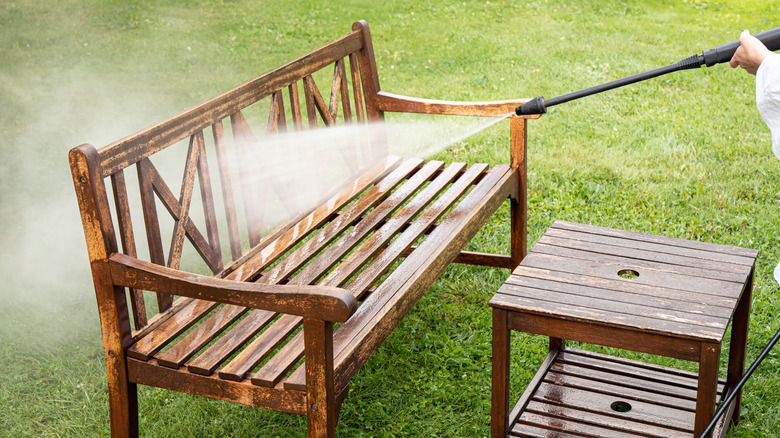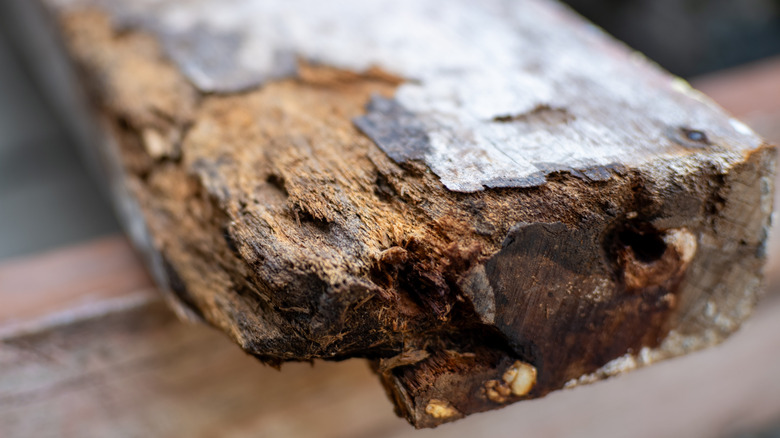Save Your Outdoor Wood Furniture From Rotting With These Expert Tips
We may receive a commission on purchases made from links.
The pleasure of enjoying a deck, patio, or lawn while comfortably lounging in a classic piece of outdoor furniture enriches our lives. As a woodworking pro who has built many outdoor pieces from chairs to picnic tables to BBQ carts, I can tell you that keeping outdoor furniture in good condition is important. It prolongs their life, protects your investment, and is one way to ensure your outdoor experiences are pleasant. This is especially true for wooden furniture such as Adirondack chairs or the like. The ravages of the sun, rain, and inclement weather take a toll on furniture is constantly exposed to the elements. Here are a few pro tips for protecting these outdoor treasures.
The first thing to do is to figure out what type of wood your pieces are made from. Proper types of wood for outdoor projects include white oak, cypress, cedar, long leaf pine, mahogany, and teak, which have characteristics that help them resist rot. Common pine lumber, like white pine or ponderosa pine, are not rot resistant and will need extra protection.
How is a person who is not a wood expert to know which is which? Here is a test that will help you sort them out. If you can push your thumbnail into the surface of the wooden furniture, it is likely to be pine, cedar, or cypress. If its unfinished color is brownish, it's cedar. If it is white or slightly yellow in hue and does not have a strong grain pattern, it's likely cypress. If it is yellow and its grain pattern is highlighted with orange lines, it is pine.
General upkeep and cleaning for wooden furniture
Keeping your outdoor furniture clean is the single most important thing you can do to prevent deterioration. At a minimum, do this annually. It's amazing how much dirt and grime builds up on them outdoors. My preference is to use a power washer on a low setting to get this process started. Then I follow up with a bucket of warm water mixed with some dishwashing detergent. Use a soft bristled brush or a cloth to scrub the furniture, then rinse clean with fresh water. Let dry completely. This can prevent fungi and bacteria, which are sources of rot, from lodging in your wooden furniture.
Next task, do a close inspection. Look for cracked wood, paint peeling away, loose screws, protruding nails, or signs of rot. You can know your wood has rotted with a few tests. While rot can look ugly and discolored, sometimes it presents as a soft "punky" area — often at the bottom of legs or end grain. Use a small screwdriver to test areas that you suspect of rot. If it pushes in easily, it's rot or its equivalent, and you've got a problem.
Then, fix any fasteners that are loose and drive exposed nail heads back into the wood. If you need to add a couple of screws or nails to firm up the furniture, now is the time to do it. If there are large cracks or voids in the wood, use Abatron wood filler epoxy kit to fix the problem. If your clear finish has turned milky colored, you'll need to sand it down and reapply a finish.
Wood finish to the outdoor furniture rescue
First things first: if your outdoor furniture is made of pine, it's time to paint it. This durable and protective outdoor finish is the only finish I recommend for pine outdoor furniture. Fill any surface cracks with a latex caulk and apply at least one coat of exterior grade paint. Regardless, if your outdoor furniture is already painted and looks bad, another coat of paint is the solution. A newly cleaned piece will be ready for another coat.
If your furniture is made of the other more durable outdoor species and has an intact clear finish (or no finish at all) there are other options available to you. Deck stains, a brush-on, or spray-on finish will spruce up the look of your furniture and provide protection from the elements. It's easily reapplied when needed. You can use General Finishes outdoor finish, which you wipe on and then wipe off the excess for a lovely low-sheen finish. These exterior oil finishes will need to be redone every year or so, but are so quick and easy to apply that I don't mind the task.
I do not recommend exterior polyurethane or true spar varnish. Those finishes look great at first, but will break down over time. Spar can be gently sanded and a new coat applied but that is a significant job. A deteriorating poly finish will look milky and dull and will need to be sanded off and reapplied. With all that in mind, the truth is that no finish on outdoor furniture will last forever. At some point you will need to repair or refinish your furniture.
Stop the rot in your wooden furniture
The best way to deal with rot is to stop it from happening in the first place. The annual cleaning is required, but if you live in a humid or rainy area, twice a year is better. The feet of outdoor furniture are often rotten because rot starts with exposure to moisture. If the feet of your furniture are end grain, they need to be specially protected. Wood consists of tightly compressed long fibers that are essentially organic straws. Trees use these fibers to move water up into the crown of the tree. When you cut off a board, the resulting "end grain" exposes those "straws" which wick moisture up into the wood fibers. That moisture combined with fungi and bacteria is the source of rot, which eats away at the wood fibers until they break down.
A good moisture barrier will prevent rot from starting. A technique called "packing" the end grain is effective. I use a layer of epoxy (a two-part hardening resin product) on the feet of outdoor furniture that have end grain exposed. I wipe on a thick layer of the epoxy and let it cure. Its plastic-like surface is durable and waterproof, even more than applying a coat of paint or other finish, as its bond with the wood fibers is exceedingly strong. As part of my yearly cleaning and inspection of my outdoor furniture, I make sure the packing is still in place. If not, another application is easy. Keep your outdoor furniture in good shape by keeping it clean, with a protective finish, and packing the end grain.



